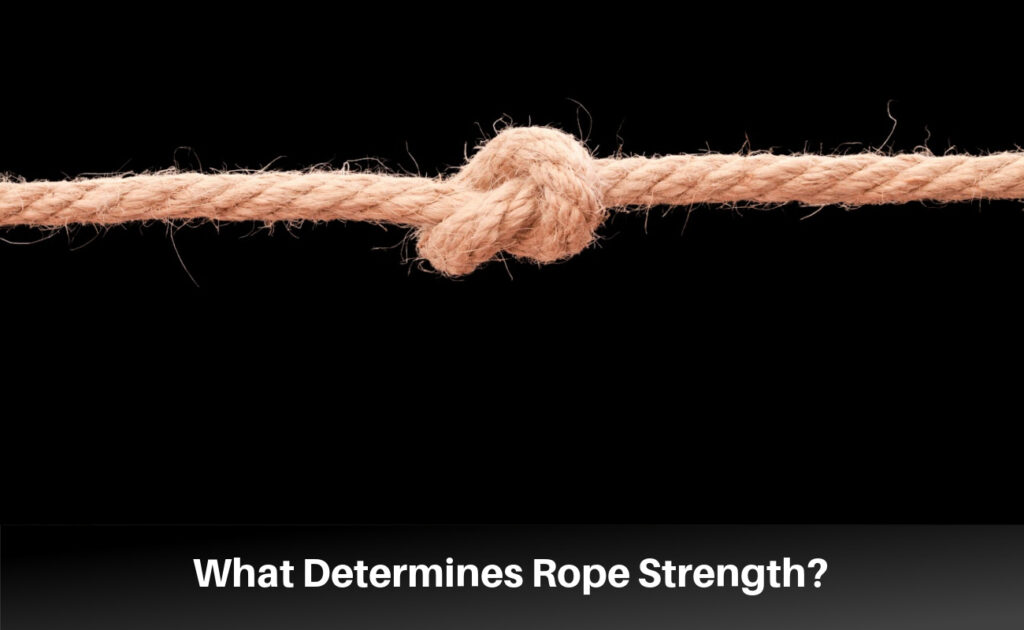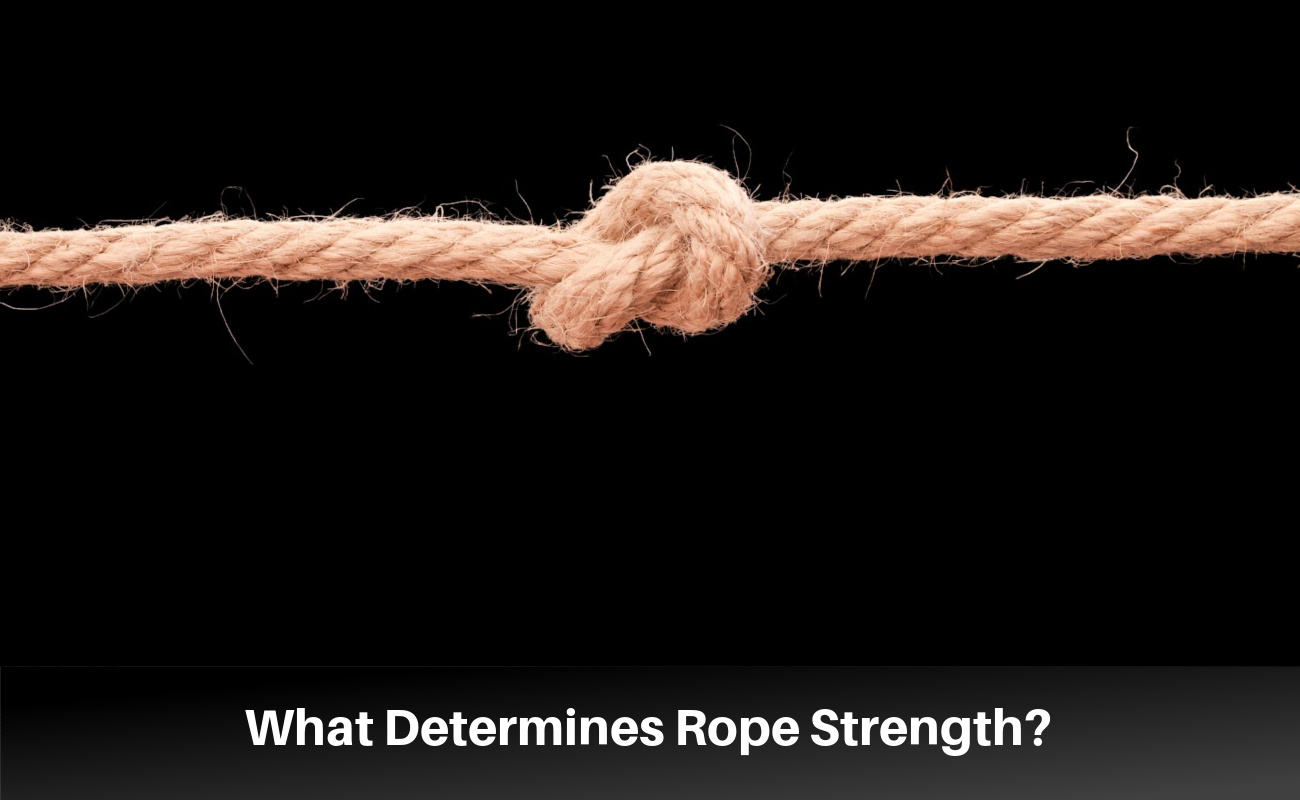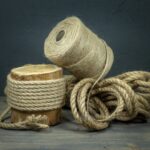Rope strength depends on the rope thickness, materials, how it is woven, and how you handle it. A strong rope, like nylon, can hold heavy loads without breaking and resists the elements.
Ropes may be braided, plaited, or twisted; how a rope is woven affects its strength. The strength of various ropes may also differ between companies. Companies that value their ropes’ safety also send them out for third-party testing.
The “tensile strength” describes the strength of a new rope under laboratory conditions. The “working load” describes the safe amount of weight you can load onto your rope. Knowing the safe working load of your rope is essential. Activities ike rock climbing, boating, or construction can be dangerous. Knowing the correct working load may save your life.

The working load of a rope decreases depending on how you handle it. Knots and abrasions are a few things that can reduce the working load of a rope.
To safely use a rope, the weight you place should always be well below the working load. Avoid abrasions, kinks, and strain, so you don’t prematurely age your rope. Avoid chemicals and water that will damage and decrease the strength of your rope. Store your ropes properly after using them.
The strongest kind of rope for common use is nylon. Eight types of rope are similarly strong:
- Aramid fiber
- HMPE
- PBO (Zylon)
- PEEK
- Polyester
- Polypropylene
- Polyethylene
- VECTRAN
For your safety, it’s always best to consult the manufacturer to determine the working load of your rope. Where ultimate safety is not a concern, it’s okay to go with estimates. Consult the charts below for tensile strength and working load averages of ropes.
What Is Rope Made Of?
A rope is a combination of fibers, filaments, or wires. Those fibers are then woven, braided, or twisted together. Weaving the fibers together creates a thicker composition called “rope.”
Rope comprises natural or synthetic fibers. Natural fibers include manila, cotton, hemp, sisal, and jute. They are weaker than synthetic fibers and decompose more quickly. Natural fibers are weaker because they’re susceptible to the elements.
Synthetic fibers comprise metals or polymers. Synthetic ropes include nylon, polyester, polyethylene, and polypropylene. The filaments are thicker, leading to a stronger and more rigid rope. They do not deteriorate as quickly and are often resistant to the elements.
How Do You Determine The Strength Of Rope?
The strength of a rope varies depending on its fibers and how they are woven together. Natural fiber ropes are less durable and more susceptible to degradation. So, they are significantly weaker than synthetic fiber ropes.
Weaving
We create ropes by weaving fibers together to make thicker materials. Some weaving methods are stronger than others. A double-braided rope is the strongest weaving pattern. They are closely followed by a hollow braid. Twisted ropes have average strength. Maypole and diamond braids are slightly weaker, and solid braids are the weakest.
Twisted ropes have a better strength-to-weight ratio than maypole, diamond, and solid braids. Still, a twisted rope’s working load is just 8-15% of its tensile weight. The working load of all other weaving patterns is about 15-20%.
Differences Between Companies
Bear in mind that the strength of a rope varies between manufacturers. Ropes have different strengths depending on whether company A or B makes them. So, do not take a rope’s general strength for an absolute fact, and know there is some variation.
Also, be cautious with the terminology manufacturers use to name a rope. Know what materials the rope comprises to determine the correct strength. For instance, “mooring lines” are not all made from the same materials or have the same strength. Some may consist of the finest materials, while others consist of cheap materials.
Handling Decreases Strength
How you handle your ropes also affects how long they will last and their condition. Tying knots in your rope significantly reduces the rope’s strength. Rough handling, like excessive friction or loading, reduces your rope’s strength faster. Ropes handled roughly, or those with knots, often lose up to ⅕ or 1/7 of their original strength.
Knots and splices are the weakest points in a rope, but splices are stronger than knots.
How Important Is It To Know Exact Strength?
Where safety is concerned, it’s best to get the specifics of your rope straight from the manufacturer. For instance, cavers, climbers, divers, and flyers need a rope’s exact specifications. Their lives depend on the safety of their rope. In less extreme situations, the approximate rope strength is usually enough.
What Is The Breaking Strength Of A Rope?
The natural breaking strength of a manila rope is used as the standard. We compare the breaking strength of a rope to that of other ropes.
Here’s how to measure the breaking strength of a manila rope:
Multiply 900 pounds by the squared circumference of the rope.
Formula: 900 lbs X circumference^2 = breaking strength
Rope is sold by the diameter, not the circumference. So, you’ll need to convert the diameter to circumference:
Circumference = 3.14 X diameter
You’ll need to do a bit of extra calculating to find the breaking strength of synthetic ropes. A “comparison factor” converts the breaking strength of manila to synthetic fibers. The comparison factor is necessary because synthetic ropes are stronger than natural ropes.
Comparison Factor Of Synthetic Ropes
| Nylon | 2.5 |
| Polypropylene | 1.4 |
Example Of Calculated Breaking Strength Of Manila Ropes:
- Begin with a ¾” diameter manila line
- Calculate the circumference — (0.75 X 3.14 = 2.36)
- Calculate the breaking strength — (2.36^2 X 900 = 5,012.64 pounds of breaking strength)
Example Of Calculated Breaking Strength Of Synthetic Ropes:
Follow the steps above
Calculate the breaking strength
Comparison factor X 900 lbs X circumference^2 = breaking strength
- Assume we are using a ¾” nylon rope with a comparison factor of 2.5
- Calculate — (2.5 X 900 X 0.75^2 = 1,260 pounds)
Being able to calculate the breaking strength does not guarantee the safety of your rope. The breaking strength formula is an average for new lines under laboratory conditions. Your rope may be above or below the average, or its strength may decrease from handling.
What Is The Tensile Strength Of A Rope?
Rope tensile strength refers to the point at which we expect a new rope to break. The rope is laboratory tested to determine how much load a rope can handle before breaking. Manufacturers test their ropes using the D-6268 or ASTM testing systems.
Some manufacturers prefer to report the minimum tensile strength rather than the average. You simply need to reduce the average by 20% to get the minimum tensile strength.
How To Measure Tensile Strength
To determine the tensile strength, workers wrap the rope around two large capstans. Then, they begin slowly adding tension to the rope until it breaks
Tensile strength only refers to brand-new ropes, not those that have been used. The use of rope significantly decreases its strength.
What Is The Working Load Limit?
The working load is the maximum weight manufacturers recommend you use on the rope. Manufacturers estimate the greatest load a rope can hold while maintaining its longevity. They make the estimate by considering the tensile strength and the rope’s characteristics. Characteristics manufacturers consider include:
- The construction
- How it’s weaved
- Longevity
- Age
- The condition of the rope.
To get the working load, divide the tensile strength by the estimated safety load.
The working load is significantly less than the tensile strength. Generally, the working load is only 15-25% of the tensile strength. The working load is lower because manipulating the rope makes it weaker than using it alone.
To be safe, most people recognize the tensile strength to working load ratio as 10:1. For instance, if the tensile strength of a rope is 5,000 pounds, then the working load would only be 500 pounds. To be extra safe, the National Fire Protection Association recommends using a ratio of 15:1. So, if the tensile strength is 5,000 pounds, the working load is only 333 pounds.
Most people add knots to their ropes which alters the strength. Most knots reduce tensile strength by about 50%. Ropes are wrapped around objects that cause abrasion. Often, they are exposed to harsh elements. Anything that causes a rope to be weaker lessens its working load.
Third–Party Testing
Most reputable rope manufacturers have third parties test the strength of their rope. Third parties often test the break strength or failure point of ropes.
A rope may have a “sharp” or “percentage” break. The sharp break occurs when the peak load measurement drops by 5% or more. Manufacturers measure the percentage break by starting with the peak load measurement. Then, they use a sample of the rope material and measure its relationship to load degradation.
How To Safely Handle Ropes
When handling a rope, never stand in line with it or within 45 degrees of it. The rope will recoil if it fails, which can cause serious injury if you’re in the way. A recoiling rope snaps back, oscillating in unpredictable patterns. Anyone in its path will be hit. Those in the path of the recoiling rope may sustain serious injuries or even death.
Work Below The Working Load
Always stay within the working load limit of your rope and avoid overloading. Only experts should attempt to go over the working load limit. They should only do so after thoroughly calculating the risks.
Avoid Abrasion, Kinks, & Strain
The inner and outer fibers both distribute the weight of the load on the rope. Avoid abrasions, which naturally weaken your rope. Use chafing gear on ropes that you must expose to friction.
Avoid sudden movement and straining. A heavy load may be safe under normal, steady conditions. Still, heavy loads may cause a rope to break when put under sudden pressure.
Like knots, kinks severely reduce the strength and durability of ropes. Avoid causing kinks in your rope. You should also avoid pulling your rope at a sharp angle, which causes a weak spot in the rope.
Alternate the working ends of your rope to prevent creating undo wear on one end of the rope. Alternating the working ends keeps the wear even across the rope. It also preserves the rope’s strength for a longer time.
Avoid The Use Of Chemicals
Avoid using chemicals with your ropes, especially with natural fiber ropes. Natural fiber ropes are not resistant to chemicals. They break down far quicker than when not exposed to chemicals. You should avoid chemicals, even with ropes resistant to them. Almost all synthetic fiber ropes resist chemicals but still break down over time.
Store Your Ropes Properly & Keep Them Clean
Keep your ropes clean and free of dirt, which causes abrasion on the surface of your ropes. You can clean ropes with plain water and dry natural fiber ropes before storing them. After cleaning, store your ropes properly to prevent further wear. Synthetic fiber ropes should avoid excessively high heat, sunlight, and water. Store natural fiber ropes in similar conditions, keeping the ropes completely dry.
Nylon — The Strongest Rope & How It Compares To Others
Nylon, or polyamide, is far superior to any other synthetic or natural fiber ropes in terms of strength.
Nylon is stronger than the other ropes and is commonly used for the heaviest loads. Nylon is also elastic and resistant to abrasion, chemicals, and UV rays.
Nylon weakens when exposed to water, but the effects are minimal. Boaters and sailors still commonly use nylon rope as mooring and anchor lines. They find their overall strength to outweigh the weakening of water.
Due to its strong properties, we often use nylon in:
- Pulley systems
- Winches
- Rescue line assemblies
- Towing lines
- Anchor lines
- Tie-downs
Aramid Fiber
Aramid ropes — Technora, Twaron, and Kevlar — are high strength but have little stretch. These ropes have high resistance to heat, creep, abrasion, and moderate UV rays. Aramid ropes often act as replacements for steel cables. They do not handle shock loads well, so they should not be used for climbing or loading.
Uses of Aramid rope:
- Boating
- Aerospace & military applications
- Electrical engineering
HMPE
High modulus polyethylene (HMPE) is stronger than aramids but weaker than nylon. Some examples include Dyneema and Spectra. These ropes are used when high strength is necessary.
These ropes are common for boating because they are hydrophobic and repel water. They are one of the best choices to use around water because they don’t weaken when wet. HMPE ropes are stretchy, resistant to heat and chemicals, and can float. One downside is that the material is slippery and hard to handle.
Uses of HMPE rope:
- Rigging
- Water-resistant clothing
- Vehicles
- Cut-resistant gloves
- Climbing equipment
- Paragliding equipment
- Suspension lines for parachutes
PBO (Zylon)
PBO, also known as “Zylon,” is a relatively new rope material. It has incredible strength, but low stretch. These ropes have a high strength-to-weight ratio. It is resistant to high temperatures but must have protection from abrasions and UV rays.
Uses of PBO (Zylon) ropes:
- Construction
- Protective clothing
- Protective coating of wires
- Reinforcement for cement
- Sports equipment (bike tires, tennis racquets, snowboards)
- Cable cover for welding machines
PEEK
Polyetheretherketone, or PEEK, is a type of polymer in the ketone family. These ropes have strong thermal stability. They are also resistant to chemicals, abrasion, and extreme temperatures.
Uses of PEEK ropes:
- Aircraft parts
- Medical implants
- Electrical cable insulation
Polyester
Polyester is not as strong as nylon, but it is still one of the best rope materials. Polyester ropes are also known as “Terylene,” “Dacron,” or “Trevira.” It is resistant to water, UV rays, and abrasion, making them incredibly durable. Polyester is also resistant to heat and does not lose much strength when wet.
Uses of polyester ropes:
- Mooring & winch lines
- Protective coverings for other ropes (such as Aramid)
- Outdoor uses
Polypropylene
Polypropylene is slightly weaker than polyester. Still, it is resistant to moderate UV levels, abrasion, chemicals, and high heat. Polypropylene is also lightweight and floats, making it popular in the boating industry.
Uses of polypropylene ropes:
- Ship’s fastener
- Mooring
- Military applications
- Water sports
Polyethylene
Polyethylene is similar to polypropylene but has better UV resistance.
Uses of polyethylene ropes:
- Fishing
- Gardening
- Sailing
- Camping
- Construction
- Pet leads
VECTRAN
VECTRAN is also known as “aromatic liquid crystal polyester.” It is incredibly strong and resistant to heat but has little stretch.
Uses of VECTRAN ropes:
- Rope coverings
- Electrical cables
- Sailcloth
- Military applications
- Mooring
- Deep-sea applications
Natural Rope Strength Chart
The tensile strength of natural ropes is less than that of synthetic ropes. Natural ropes are weaker because they break down quickly when exposed to elements.
To compare to synthetic ropes, a natural rope’s diameter would need to increase by at least 25%. Some natural ropes, like sisal, would need a more significant increase in diameter — at least 33.3%.
Still, the tensile strength of all ropes is compared to that of manila rope. The strength of manila ropes is considered the standard. We look to manila when determining the strength of other ropes. Review this table for manila rope’s tensile strength:
Approximate 3-Strand Twisted Manila Rope Tensile Strength By Thickness
| Diameter | Load (Pounds) |
|---|---|
| 16 mm (⅝ in) | 406 |
| 25 mm (1 in) | 900 |
| 38 mm (1.5 in) | 2,380 |
| 45 mm (1 ¾ in) | 3,100 |
| 51 mm (2 ¼ in) | 4,860 |
| 70 mm (2 ¾ in) | 6,950 |
| 89 mm (3 ½ in) | 10,800 |
| 102 mm (4 in) | 13,500 |
The working load is generally about 15-25% of a rope’s tensile strength. So, the load a rope can support is relatively lower. Review this table for manila rope’s average working loads:
Approximate 3-Strand Twisted Manila Rope Working Load By Thickness
| Diameter | Load (Pounds) |
| 16 mm (⅝ in) | 41 |
| 25 mm (1 in) | 90 |
| 38 mm (1.5 in) | 264 |
| 45 mm (1 ¾ in) | 388 |
| 51 mm (2 ¼ in) | 695 |
| 70 mm (2 ¾ in) | 995 |
| 89 mm (3 ½ in) | 1,540 |
| 102 mm (4 in) | 1,930 |
Synthetic Rope Tensile Strength
The tensile strength depends on the materials, thickness, and how the fibers are woven. Consult this chart to compare the tensile strength of variously woven nylon ropes:
Approximate Nylon Rope Tensile Strength By Thickness (Pounds)
| Diameter | Nylon Double Braid | Nylon 3-Strand Twisted | Nylon 12-Strand Plait | Nylon Solid Braid |
| 6 mm (¼ in) | 1,700 | 1,650 | 2,000 | 1,325 |
| 10 mm (⅜ in) | 4,100 | 3,700 | 4,600 | 3,000 |
| 16 mm (⅝ in) | 14,600 | 10,400 | 13,900 | — |
| 25 mm (1 in) | 33,200 | 25,000 | 30,100 | — |
| 38 mm (1.5 in) | 74,000 | 53,000 | 64,800 | — |
| 45 mm (1 ¾ in) | 109,500 | N/A | 92,100 | — |
| 51 mm (2 ¼ in) | 129,700 | 90,000 | 106,000 | — |
| 64 mm (2 ⅝ in) | 196,000 | 125,000 | 170,000 | — |
| 76 mm (3 in) | 274,000 | 195,000 | 245,000 | — |
| 92 mm (3 ⅝ in) | 400,000 | N/A | 338,000 | — |
Consult this chart to compare the tensile strength of variously woven polyester ropes:
Approximate Polyester Rope Tensile Strength By Thickness (Pounds)
| Diameter | Polyester Double Braid | Polyester Solid Braid | Polyester 3-Strand Twisted | Polyester 12-Strand Plait |
| 6 mm (¼ in) | 2,000 | 1,000 | 1,650 | 2,100 |
| 10 mm (⅜ in) | 4,400 | 2,500 | — | 4,600 |
| 16 mm (⅝ in) | 14,000 | — | 10,000 | 12,100 |
| 25 mm (1 in) | 38,000 | — | 22,000 | 27,500 |
| 38 mm (1.5 in) | 72,000 | — | 46,000 | 59,600 |
| 45 mm (1 ¾ in) | 89,200 | — | — | 84,400 |
| 57 mm (2 ¼ in) | 141,000 | — | — | 137,000 |
| 67 mm (2 ⅝ in) | 186,000 | — | — | 179,000 |
| 76 mm (3 in) | 237,000 | — | — | 233,000 |
| 92 mm (3 ⅝ in) | 348,000 | — | — | 340,000 |
Consult this chart to compare the tensile strength of variously woven polypropylene ropes:
Approximate Polypropylene Rope Tensile Strength By Thickness (Pounds)
| Diameter | Polypropylene 3-Strand Twisted | Polypropylene 8-Strand Hollow Braid |
| 6 mm (¼ in) | 1,250 | 900 |
| 10 mm (⅜ in) | 2,700 | 1,600 |
| 16 mm (⅝ in) | 6,200 | — |
| 25 mm (1 in) | 14,000 | — |
| 38 mm (1.5 in) | 29,700 | — |
| 45 mm (1 ¾ in) | 43,000 | — |
| 57 mm (2 ¼ in) | 69,000 | — |
| 67 mm (2 ⅝ in) | — | — |
| 76 mm (3 in) | 114,000 | — |
| 92 mm (3 ⅝ in) | — | — |
Synthetic Rope Working Load
Knowing the working load of your rope keeps you safe and prevents accidents. You should never use a rope close to its working load or breaking strength. In most instances, the working load of a rope is about 15-25% of the rope’s tensile strength.
Consult this chart to compare the working load of variously woven nylon ropes:
Approximate Nylon Rope Working Load By Thickness (Pounds)
| Diameter | Nylon Double Braid | Nylon 3-Strand Twisted | Nylon 12-Strand Plait | Nylong Solid Braid |
| 6 mm (¼ in) | 340 | 330 | 400 | 265 |
| 10 mm (⅜ in) | 820 | 740 | 920 | 600 |
| 16 mm (⅝ in) | 2,920 | 2,080 | 2,780 | — |
| 25 mm (1 in) | 6,640 | 5,000 | 6,020 | — |
| 38 mm (1.5 in) | 14,800 | 10,600 | 12,960 | — |
| 45 mm (1 ¾ in) | 21,900 | — | 18,420 | — |
| 51 mm (2 ¼ in) | 25,940 | 18,000 | 21,200 | — |
| 64 mm (2 ⅝ in) | 196,000 | 25,000 | 34,000 | — |
| 76 mm (3 in) | 54,800 | 39,000 | 49,000 | — |
| 92 mm (3 ⅝ in) | 80,000 | — | 67,600 | — |
Consult this chart to compare the working load of variously woven polyester ropes:
Approximate Polyester Rope Working Load By Thickness (Pounds)
| Diameter | Polyester Double Braid | Polyester Solid Braid | Polyester 3-Strand Twisted | Polyester 12-Strand Plait |
| 6 mm (¼ in) | 400 | 200 | 825 | 420 |
| 10 mm (⅜ in) | 880 | 500 | — | 920 |
| 16 mm (⅝ in) | 2,800 | — | 5,000 | 2,420 |
| 25 mm (1 in) | 7,600 | — | 11,000 | 5,500 |
| 38 mm (1.5 in) | 14,400 | — | 23,400 | 11,920 |
| 45 mm (1 ¾ in) | 17,840 | — | — | 16,880 |
| 57 mm (2 ¼ in) | 28,200 | — | — | 27,400 |
| 67 mm (2 ⅝ in) | 37,200 | — | — | 35,800 |
| 76 mm (3 in) | 47,400 | — | — | 46,600 |
| 92 mm (3 ⅝ in) | 69,600 | — | — | 68,000 |
Consult this chart to compare the working load of variously woven polypropylene ropes:
Approximate Polypropylene Rope Working Load By Thickness (Pounds)
| Diameter | Polypropylene 3-Strand Twisted | Polypropylene 8-Strand Hollow Braid |
| 6 mm (¼ in) | 213 | 153 |
| 10 mm (⅜ in) | 459 | 272 |
| 16 mm (⅝ in) | 1,054 | — |
| 25 mm (1 in) | 2,380 | — |
| 38 mm (1.5 in) | 5,049 | — |
| 45 mm (1 ¾ in) | 7,310 | — |
| 57 mm (2 ¼ in) | 11,730 | — |
| 67 mm (2 ⅝ in) | — | — |
| 76 mm (3 in) | 19,380 | — |
| 92 mm (3 ⅝ in) | — | — |
Resistance Of Natural & Synthetic Ropes
A rope’s strength also depends on the rope’s resistance to natural and artificial elements. Review this table to see the resistance and durability of natural fiber ropes:
Resistance Of Natural Ropes
| Cotton | Hemp | Manila | Sisal | |
| Abrasion Resistance | Fair | Good | Good | Fair |
| Acid Resistance | Poor | Poor | Poor | Poor |
| Alkali Resistance | Fair | Fair | Fair | Fair |
| Buoyancy | Sinks | Sinks | Sinks | Sinks |
| Durability | Fair | Great | Good | Poor |
| Handling | Great | Good | Fair | Poor |
| Rot & Mildew Resistance | Poor | Poor | Poor | Poor |
| Shock Loading | Poor | Good | Fair | Poor |
| Storage | Dry | Dry | Dry | Dry |
| U.V. Resistance | Great | Great | Great | Great |
Review this table to see the resistance and durability of synthetic fiber ropes:
Resistance Of Synthetic Ropes
| Polyamide | Polyester | Polyethylene | Polypropylene | |
| Abrasion Resistance | Great | Great | Fair | Fair |
| Acid Resistance | Good | Great | Great | Great |
| Alkali Resistance | Great | Great | Great | Great |
| Buoyancy | Sinks | Sinks | Slightly Floats | Floats |
| Durability | Great | Great | Fair | Good |
| Handling | Great | Great | Good | Good |
| Melting Point | About 250°C (484°F) | About 245°C (473°F) | About 128°C (262°F) | About 150°C (302°F) |
| Rot & Mildew Resistance | Great | Great | Great | Great |
| Shock Loading | Great | Fair | Poor | Good |
| Storage | Wet or Dry | Wet or Dry | Wet or Dry | Wet or Dry |
| U.V. Resistance | Fair | Great | Fair | Poor |
FAQs
How To Break In A New Rope
How you break in a new rope varies slightly depending on what you’re using it for. For instance, horseback riders break in their rope quite differently than rock climbers.
Rock climbers may take these steps to break in their rope:
1. Washing the rope with some detergent & letting it dry under constant tension
2. Oiling & waxing it by hand
Horseback riders may take these steps to break in their rope:
1. Stretch the rope with a post and saddle horn to improve flexibility
2. Coat the length of the rope in baby powder
Experts recommend simply using and caring for your rope correctly, and it will begin to soften on its own. Many suggestions for “breaking in” your rope prematurely age and break down your rope.
Does Doubling Rope Double Its Strength?
Technically, doubling the rope does not double the strength. A doubled rope still has the same strength, but you’re spreading the weight of the load over a larger area. So, the rope’s strength doesn’t increase, but the load placed on the rope decreases. So, it’s still helpful to double a rope when placing a heavy load.
Why Does Braiding Increase Rope Strength?
Braided fibers — i.e., woven into each other — are stronger. They are stronger because they are more tightly bound together. Braided fibers also have a better ability to stretch and are more flexible. Twisted fibers are laid against each other straight, so they don’t support each other. They also have less stretching capability but are more likely to compress.





